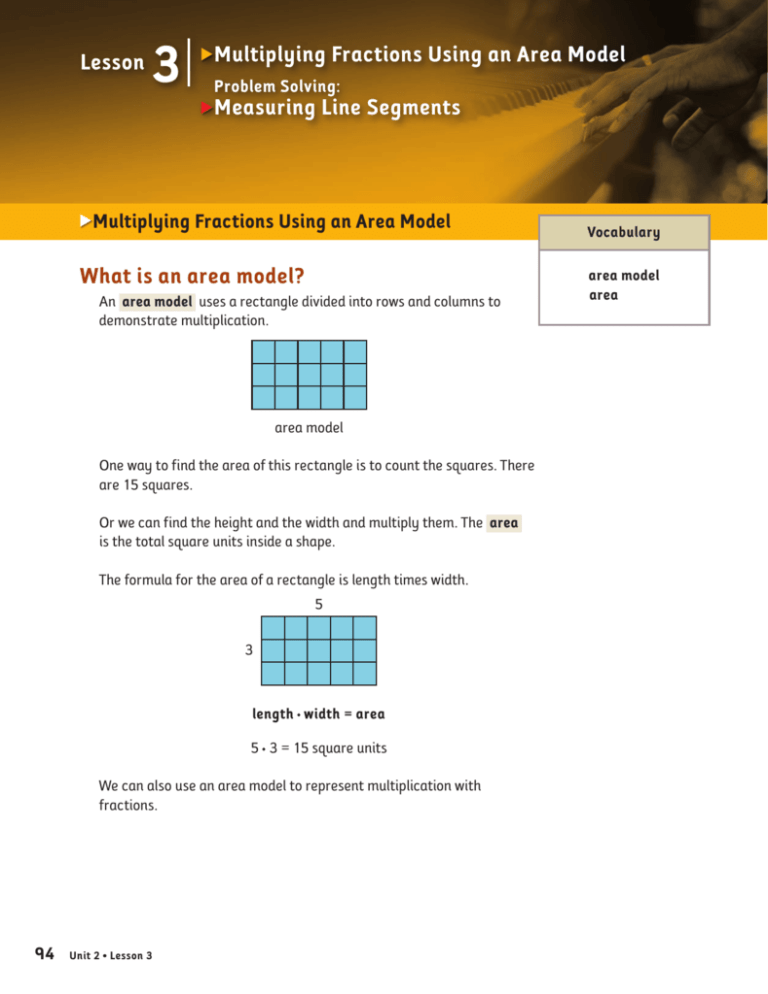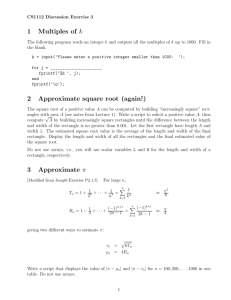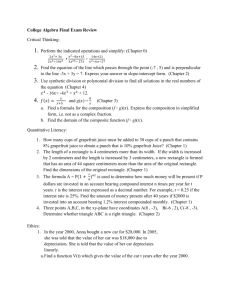
Lesson
3 Multiplying Fractions Using an Area Model
Problem Solving:
Measuring Line Segments
Multiplying Fractions Using an Area Model
What is an area model?
An area model uses a rectangle divided into rows and columns to
demonstrate multiplication.
area model
One way to find the area of this rectangle is to count the squares. There
are 15 squares.
Or we can find the height and the width and multiply them. The area is the total square units inside a shape.
The formula for the area of a rectangle is length times width.
5
3
length · width = area
5 · 3 = 15 square units
We can also use an area model to represent multiplication with
fractions.
94 Unit 2 • Lesson 3
Vocabulary
area model
area
Lesson 3
Let’s use an area model to multiply fractions.
Example 1
Multiply the fractions using an area model.
2 1
3·4
1
In this problem, we want to find 2
3 of 4 .
First we divide the height of a rectangle into 4 equal parts.
We shade one part to represent 1
4.
Next, we divide the width of the rectangle into 3 equal parts and
we shade 2 parts to make 2
3.
We must use a different
shading pattern to show 2
3.
Now we can figure out the product.
2 parts overlap.
The part where the shading overlaps represents the numerator.
The total number of parts represents the denominator.
There are 12 total parts and 2 of the parts overlap.
The product is 122 .
1
2
We took 2
3 of 4 and got 12 .
There are 12 total parts.
Notice that the product is
2
smaller than 1
4 or 3 .
Unit 2 • Lesson 3 95
Lesson 3
Let’s look at another example. This time the fractional parts are thirds
and halves.
Example 2
Multiply using an area model.
1 1
2·3
We divide a rectangle into 3 equal parts. We shade one of those parts
to make 1
3.
Next, we divide the width of the rectangle into two equal parts and
shade one of the parts to make 1
2.
Remember to use a
different shading pattern.
Now we can find the product.
The numerator is where the shading overlaps, or 1 unit.
The denominator is the total number of parts, or 6 units.
The product is 16 .
1
1
We took 1
2 of 3 and got 6 .
1 1
1
2·3=6
The product is
1
smaller than 1
2 or 3 .
The area model gives us a good picture of what is happening when we
multiply two fractions. We can see the problem in two dimensions. We
represent the height using one fraction and the width using another
fraction. It is important to see these kinds of connections in mathematics.
Apply Skills
Turn to Interactive Text,
page 53.
96 Unit 2 • Lesson 3
Reinforce Understanding
Use the mBook Study Guide
to review lesson concepts.
Lesson 3
Problem Solving: Measuring Line Segments
How do we measure using centimeters?
In the last lesson, we looked at measuring with a metric ruler. We saw
how the metric ruler is broken into millimeters and centimeters. Today
we will measure in centimeters.
The metric ruler looks like this.
Centimeters are the longest lines with
numbers marking them.
cm 1
2
3
4
5
6
We see that sometimes a measurement may fall in between the
centimeters. In this case, we use rounding. Let’s measure some line
segments and round to the nearest centimeter.
Example 1
Measure each line segment to the nearest centimeter.
Measure this line segment:
cm 1
2
3
4
5
6
This line segment is between
5 and 6 centimeters, but
7 8
closer to 5. We round the
measurement to 5 cm.
6
This line segment is between
3 and 4 centimeters, but
7 8
closer to 4. We round this
measurement to 4 cm.
Measure this line segment:
cm 1
2
3
4
5
Problem-Solving Activity
Turn to Interactive Text,
page 54.
Reinforce Understanding
Use the mBook Study Guide
to review lesson concepts.
Unit 2 • Lesson 3 97
Lesson 3
Homework
Activity 1
Find the product by looking at the area model.
Model
2
5
· 34 6
Answer: 20
1.
1
2
· 34 3
8
2. 4 · 5 3.
3
4
· 23 6
12
4.
1
2
1
3
· 12 2
20
1
6
Activity 2
Draw area models to find the products.
Model
1
4
1
Answer: 16
1.
1
2
· 14 Overlaps here
16 total parts
· 13
1
1
2. 4 · 3
3.
1
4
· 12
Activity 3 • Distributed Practice
Solve.
1.
5.
3
4
4
2 6
8 +8
8
1
2
+ 14
3
1
2. 5 − 5
6.
2
5
2,007
1,992
15
98 Unit 2 • Lesson 3
− 13
2
6
3.
4
6
7.
4,957
+ 2,153
7,110
+ 19
5
18
4.
1
6
8.
153
6
918
Copyright 2010 by Cambium Learning Sopris West®. All rights reserved. Permission is granted to reproduce this page for student use.









